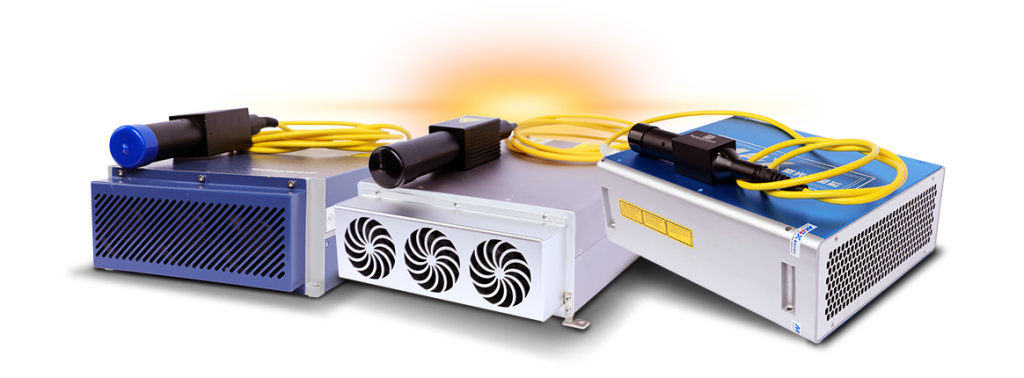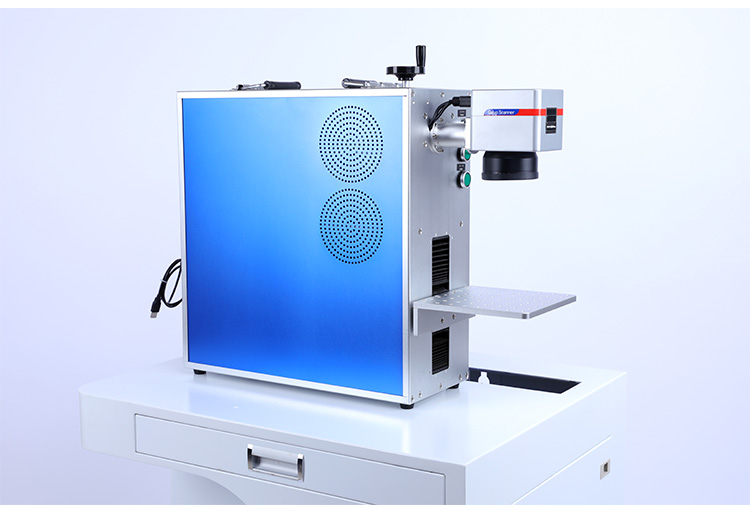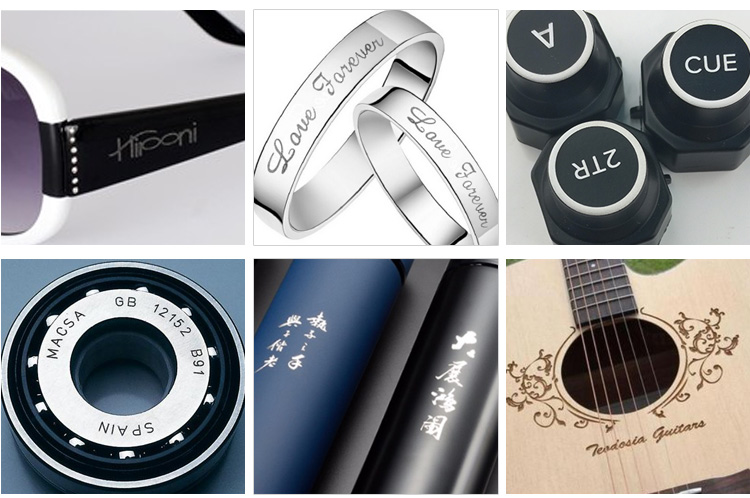Laser Knowledge
What Are Laser Marking Machine Advantages?
A fiber laser etcher can engrave permanent marks including letters, numbers, signs, logos, patterns, pictures on 2D/3D surfaces of bare metals and coated metals including carbon steel, stainless steel, galvanized steel, aluminum, brass, copper, silver, gold, titanium, iron and alloy, as well as fiberglass and plastics including PVC, PLT, PS, ABS, PBT. With a higher power, it can do relief engraving and deep engraving on metals. With a rotary attachment, it can do rotary engraving on rings, cups, and cylinders. With a belt conveyor, it can do marking on the fly in industrial assembly line manufacturing. In addition, with a MOPA laser source, it can do color engraving on stainless steel, chromium and titanium.

Laser Marking Machine
A fiber laser engraver is an automatic marking system that uses a focused fiber laser beam to etch the surface of a substrate, changing its properties and appearance to create permanent marks. Fiber laser generators are available from well-known brands such as IPG, Raycus, JPT, and Max. 20W, 30W, 50W, 60W and 100W power options are available for engravings of various thicknesses. A fiber laser marking machine features with high speed, high quality, high precision, no pollution, safety, convenient operation, maintenance-free, and low cost.

Here are some key advantages of laser marking machines
- High Precision: Laser marking machines use focused laser beams to create precise and intricate marks on the surface of the material. They can achieve high-resolution marks, fine details, and small characters with exceptional accuracy. This precision is especially useful for applications that require marking on small or delicate components.
- Permanent and Durable Marks: Laser marking creates permanent marks on the material surface. The marks are highly resistant to wear, fading, and corrosion, ensuring long-lasting visibility and legibility. This durability is crucial for applications where the marks need to withstand harsh environments or extended product lifecycles.
- Versatility: Laser marking machines can mark a wide range of materials, including metals, plastics, ceramics, glass, and more. They can be used for marking logos, serial numbers, barcodes, QR codes, text, graphics, and other types of information. The flexibility to mark different materials and designs makes laser marking suitable for various industries and applications.
- Non-Contact Process: Laser marking is a non-contact process, meaning the laser beam does not physically touch the material surface. This eliminates the risk of damage or deformation to delicate or sensitive materials. It also allows for marking on irregularly shaped or uneven surfaces without requiring additional fixturing.
- Speed and Efficiency: Laser marking machines offer high-speed marking capabilities, allowing for efficient marking processes, especially when compared to traditional marking methods such as mechanical engraving or ink printing. The laser beam can quickly move across the material surface, resulting in shorter production cycles and increased productivity.
- Environmentally Friendly: Laser marking is a clean and environmentally friendly marking method. It doesn’t involve the use of inks, chemicals, or solvents, reducing waste and eliminating the need for consumables. Additionally, laser marking machines consume less energy compared to other marking technologies, making them energy-efficient and eco-friendly.
- Software Control and Automation: Laser marking machines can be easily integrated into automated production lines and controlled through software interfaces. This allows for precise control over the marking process, easy customization of marking parameters, and seamless integration with other production equipment.
- Cost-Effective: While the initial investment in a laser marking machine may be higher than traditional marking equipment, laser marking offers long-term cost savings. The durability of laser marks reduces the need for re-marking or rework, saving time and resources. Additionally, the non-contact process eliminates the need for consumables, reducing ongoing operational costs.
Analysis of characteristics of laser marking machine
1. The laser marking machine has the characteristics of no adjustment, no maintenance, high reliability, and is especially suitable for the fields with high requirements for fineness, depth, and smoothness, so it is widely used in the luxury industry and industrial products. The metal products that can be processed include iron, copper, stainless steel, gold, alloy, aluminum, silver, and all metal oxides.
2. The laser marking machine can mark all kinds of characters, serial numbers, product numbers, barcodes, QR codes, production dates, etc. on the hardware products, and the time, date or serial numbers, product numbers can be automatically skipped.
3. The words and graphics marked by laser are not only clear and fine, but also can not be erased and modified. This is very beneficial to the tracking of product quality and channels, and can effectively prevent the sale of expired products, anti-counterfeiting, and prevent cross shipment.


Laser Marking Principle
Laser marking is a new type of non-contact, non-polluting and non-damaging engraving process. It integrates laser technology, computer technology and mechatronics technology. It is currently the mostly used advanced manufacturing technology. The principle is a marking method that uses high-energy-density laser to irradiate the workpiece locally to vaporize the surface material or undergo a chemical reaction of color change, thereby leaving a permanent mark. The process can be divided into the following steps:
Step 1: The laser acts on the surface of the material. The beam used in the field is usually a pulsed laser, and it outputs a pulse within a specific period of time. To control the beam acting on the material, it is necessary to control important parameters such as scanning speed and scanning distance.
Step 2: The material absorbs the laser energy. After the beam acts on the surface of the material, most of the energy is reflected, and only a small part of the energy is absorbed by the material and converted into heat. It needs to absorb enough energy to melt/vaporize the surface material.
Step 3: Local expansion occurs on the surface of the material, the roughness changes, and the mark is formed. When the material is melted and cooled in a short period of time, the roughness of the material surface will change, forming a permanent mark, which includes texts, patterns, signs and graphics.
There are both 2D mark for flat surfaces, and 3D mark for curved surfaces.


2D Marking System
The mirror galvanometers are used to scan the beam and mark on 2D surface. The f˜ lens is used to concentrate the light on the 2D surface.
3D Marking System
The mirror galvanometers are used to scan the beam and mark on 3D surface. They will move the focus lens (instead of f˜ lens) back and start adjusting the beam not only on X axis and Y axis, but also on Z axis.
Marking Process
The system has six different marking processes include annealing engraving, marking, staining, foaming, removing and carbonizing, which is widely used in industrial manufacturing applications, school education, small businesses, home business, small shop and home shop.

IGOLDEN BLOG
Thank you for visiting the iGOLDENCNC website. iGOLDENCNC is the professional supplier of CNC machinery application solution, within the business of producing and selling CNC machinery and accessories.